初中英语一般现在时的定义,构成,用法
- 格式:doc
- 大小:38.00 KB
- 文档页数:3
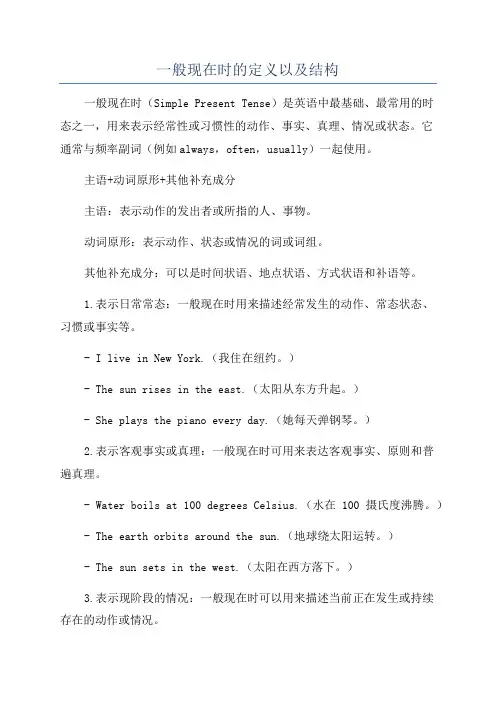
一般现在时的定义以及结构一般现在时(Simple Present Tense)是英语中最基础、最常用的时态之一,用来表示经常性或习惯性的动作、事实、真理、情况或状态。
它通常与频率副词(例如always,often,usually)一起使用。
主语+动词原形+其他补充成分主语:表示动作的发出者或所指的人、事物。
动词原形:表示动作、状态或情况的词或词组。
其他补充成分:可以是时间状语、地点状语、方式状语和补语等。
1.表示日常常态:一般现在时用来描述经常发生的动作、常态状态、习惯或事实等。
- I live in New York.(我住在纽约。
)- The sun rises in the east.(太阳从东方升起。
)- She plays the piano every day.(她每天弹钢琴。
)2.表示客观事实或真理:一般现在时可用来表达客观事实、原则和普遍真理。
- Water boils at 100 degrees Celsius.(水在100摄氏度沸腾。
)- The earth orbits around the sun.(地球绕太阳运转。
)- The sun sets in the west.(太阳在西方落下。
)3.表示现阶段的情况:一般现在时可以用来描述当前正在发生或持续存在的动作或情况。
- I am studying for my exam.(我正在为考试而学习。
)- They are playing football right now.(他们正在踢足球。
)4.表示固定行程或计划:一般现在时可用来描述固定的行程、计划或安排。
- The train leaves at 6 o'clock every morning.(火车每天早上6点离开。
)- We have English class on Mondays and Wednesdays.(我们在周一和周三上英语课。
)5.表示客观性的评论、意见或建议:一般现在时还可用来表示客观性的评论、意见或建议。
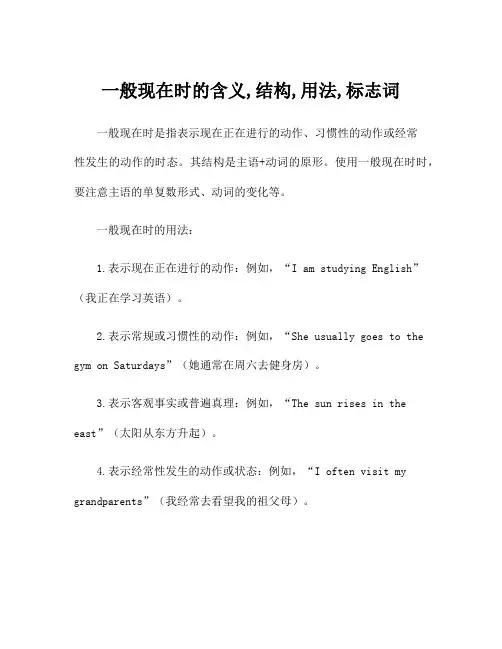
一般现在时的含义,结构,用法,标志词一般现在时是指表示现在正在进行的动作、习惯性的动作或经常性发生的动作的时态。
其结构是主语+动词的原形。
使用一般现在时时,要注意主语的单复数形式、动词的变化等。
一般现在时的用法:1.表示现在正在进行的动作:例如,“I am studying English”(我正在学习英语)。
2.表示常规或习惯性的动作:例如,“She usually goes to the gym on Saturdays”(她通常在周六去健身房)。
3.表示客观事实或普遍真理:例如,“The sun rises in the east”(太阳从东方升起)。
4.表示经常性发生的动作或状态:例如,“I often visit my grandparents”(我经常去看望我的祖父母)。
一般现在时的标志词常常包括:usually(通常)、always(总是)、often(经常)、sometimes(有时候)、every day(每天)、on weekdays(平日)、in the morning(在早晨)等。
拓展:使用一般现在时要注意以下几点:1.在第三人称单数形式中,要在动词末尾加上“-s”或“-es”,例如,“She eats breakfast every morning”(她每天早上吃早餐)。
2.在第三人称单数形式中,当动词以“-ss”、“-ch”、“-sh”、“-x”或“-o”结尾时,要在动词末尾加上“-es”,例如,“He watches TV every evening”(他每天晚上看电视)。
3.表示现在正在进行的动作时,要在be动词后面加上动词的ing形式,例如,“They are playing basketball”(他们正在打篮球)。
4.有些动词在一般现在时中有特殊变化,例如,do的第三人称单数形式为does,have的第三人称单数形式为has等。
总之,一般现在时是用来表示现在正在进行、习惯性的或经常性发生的动作,通过合适地选择动词的形式和标志词,可以准确地表达当前情况或常态。
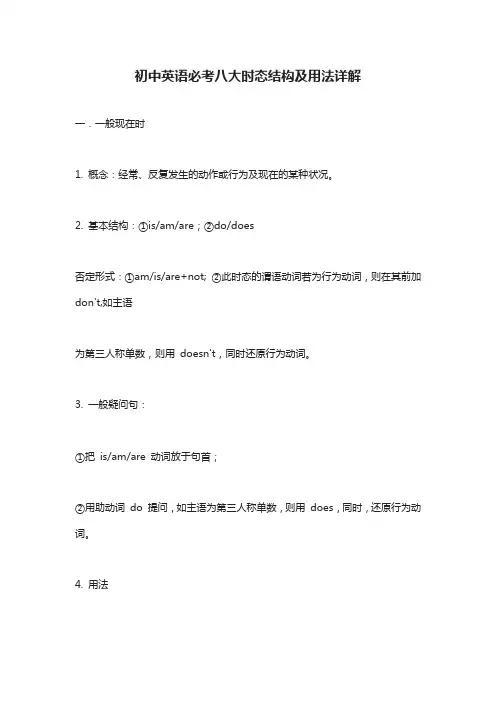
初中英语必考八大时态结构及用法详解一.一般现在时1. 概念:经常、反复发生的动作或行为及现在的某种状况。
2. 基本结构:①is/am/are;②do/does否定形式:①am/is/are+not; ②此时态的谓语动词若为行为动词,则在其前加don't,如主语为第三人称单数,则用doesn't,同时还原行为动词。
3. 一般疑问句:①把is/am/are 动词放于句首;②用助动词do 提问,如主语为第三人称单数,则用does,同时,还原行为动词。
4. 用法1)经常性或习惯性的动作,常与表示频度的时间状语连用。
例如:I leave home for school at 7 every morning. 每天早上我七点离开家。
2)客观真理,客观存在,科学事实。
例如:The earth moves around the sun. 地球绕太阳转动。
Shanghai lies in the east ofChina. 上海位于中国东部。
3)表示格言或警句。
例如:Pride goes before a fall 骄者必败。
注意:此用法如果出现在宾语从句中,即使主句是过去时,从句谓语也要用一般现在时。
例如:Columbus proved that the earth is round. 哥伦布证实了地球是圆的。
4)现在时刻的状态、能力、性格、个性。
例如:I don't want so much. 我不要那么多。
Ann writes good English but does not speak well.安英语写得不错,讲的可不行。
5)一般现在时表示将来含义。
a. 下列动词come, go, arrive, leave, start, begin, return 的一般现在时可以表示将来,主要用来表示在时间上已确定或安排好的事情。
例如:The train leaves at six tomorrow morning. 火车明天上午六点开。
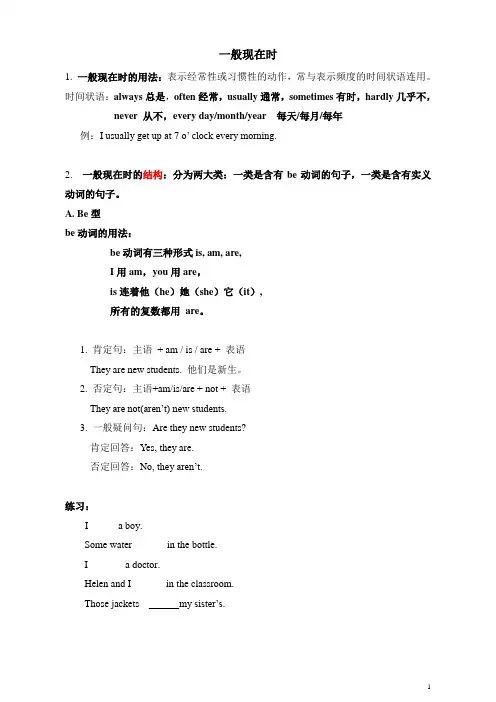
一般现在时1. 一般现在时的用法:表示经常性或习惯性的动作,常与表示频度的时间状语连用。
时间状语:always总是,often经常,usually通常,sometimes有时,hardly几乎不,never 从不,every day/month/year 每天/每月/每年例:I usua lly get up at 7 o’ clock every morning.2. 一般现在时的结构:分为两大类:一类是含有be动词的句子,一类是含有实义动词的句子。
A. Be型be动词的用法:be动词有三种形式is, am, are,I用am,you用are,is连着他(he)她(she)它(it),所有的复数都用are。
1. 肯定句:主语+ am / is / are + 表语They are new students. 他们是新生。
2. 否定句:主语+am/is/are + not + 表语They are not(aren’t) new students.3. 一般疑问句:Are they new students?肯定回答:Yes, they are.否定回答:No, they aren’t.练习:I _____ a boy.Some water ______ in the bottle.I _______a doctor.Helen and I_______in the classroom.Those jackets________my sister’s.含有实义动词B. Do型1.肯定句:主语+行为动词+其它I read English every morning.2.否定句:主语+don’t+动词原形+其它I don’t read English every morning.3.一般:Do +主语+动词原形+其它+?Do you read English every morning?肯定:Yes, I do.否定:No, I don’t.C. Does 型1.肯定:主语+行为动词+其他She gets up at 7 o’ clock every morning.2.否定:主语+doesn’t+动词原形+其他She doesn’t get up at7 o’ clock every morning.3.一般:Does she get up at 7 o’ clock every morning?肯定:Yes, she does.否定:No, she doesn’t.重点:一般现在时的第三人称单数当主语是第三人称单数的时候,谓语动词要变化形式,即动词的第三人称单数形式。
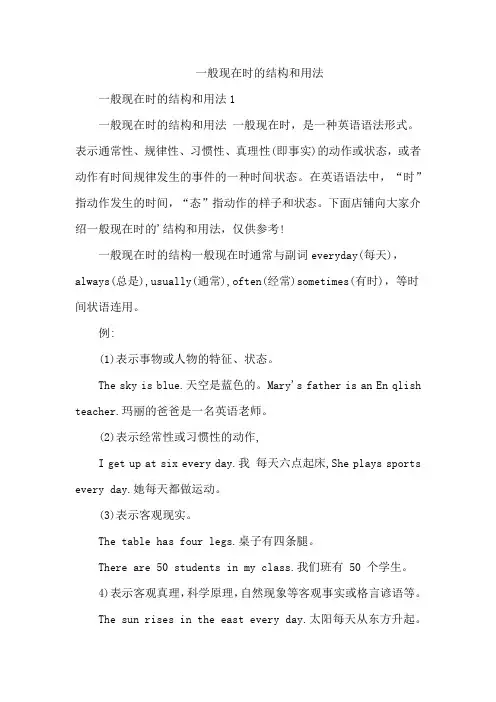
一般现在时的结构和用法一般现在时的结构和用法1一般现在时的结构和用法一般现在时,是一种英语语法形式。
表示通常性、规律性、习惯性、真理性(即事实)的动作或状态,或者动作有时间规律发生的事件的一种时间状态。
在英语语法中,“时”指动作发生的时间,“态”指动作的样子和状态。
下面店铺向大家介绍一般现在时的'结构和用法,仅供参考!一般现在时的结构一般现在时通常与副词everyday(每天),always(总是),usually(通常),often(经常)sometimes(有时),等时间状语连用。
例:(1)表示事物或人物的特征、状态。
The sky is blue.天空是蓝色的。
Mary's father is an En qlish teacher.玛丽的爸爸是一名英语老师。
(2)表示经常性或习惯性的动作,I get up at six every day.我每天六点起床,She plays sports every day.她每天都做运动。
(3)表示客观现实。
The table has four legs.桌子有四条腿。
There are 50 students in my class.我们班有 50 个学生。
4)表示客观真理,科学原理,自然现象等客观事实或格言谚语等。
The sun rises in the east every day.太阳每天从东方升起。
The earth goes around the sun.地球绕着太阳转。
(5) 表示平日的喜好。
I like bananas. We don't like vegetables.He likes ice cream.She doesn't like strawberries.一般现在时的用法经常性或习惯性的动作,常与表示频腮度的时间状语连用。
(1)时间状语:every.. sometimes, at.. on Sun dayi leave home for school at 7 every morning.(2)客观真理,客观存在,科学事实。
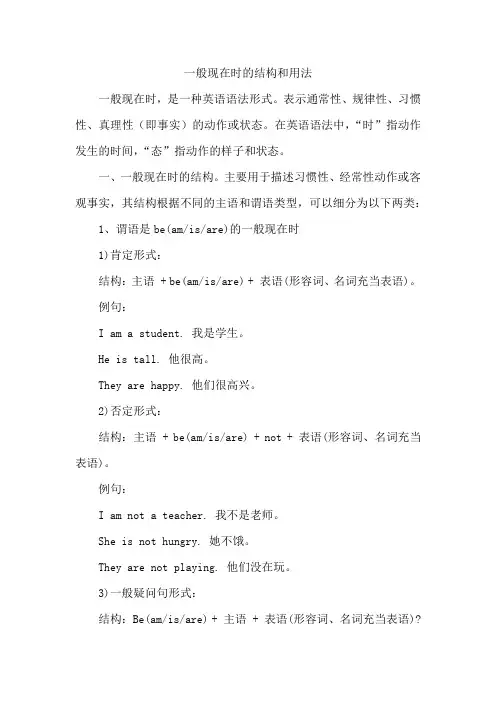
一般现在时的结构和用法一般现在时,是一种英语语法形式。
表示通常性、规律性、习惯性、真理性(即事实)的动作或状态。
在英语语法中,“时”指动作发生的时间,“态”指动作的样子和状态。
一、一般现在时的结构。
主要用于描述习惯性、经常性动作或客观事实,其结构根据不同的主语和谓语类型,可以细分为以下两类:1、谓语是be(am/is/are)的一般现在时1)肯定形式:结构:主语 + be(am/is/are) + 表语(形容词、名词充当表语)。
例句:I am a student. 我是学生。
He is tall. 他很高。
They are happy. 他们很高兴。
2)否定形式:结构:主语 + be(am/is/are) + not + 表语(形容词、名词充当表语)。
例句:I am not a teacher. 我不是老师。
She is not hungry. 她不饿。
They are not playing. 他们没在玩。
3)一般疑问句形式:结构:Be(am/is/are) + 主语 + 表语(形容词、名词充当表语)?例句:Are you a student?你是学生吗?Is he tall?他高吗?Are they happy?他们高兴吗?4)特殊疑问句形式:结构:特殊疑问词 + Be(am/is/are)开头的一般疑问句?例句:What are you?你是什么职业?Who is she?她是谁?2、谓语是实义动词(及物动词或不及物动词)的一般现在时1)肯定形式:当主语为第三人称单数时:主语 + 动词第三人称单数形式 + 其他。
例句:He speaks English. 他说英语。
2)当主语为非第三人称单数时:主语 + 动词原形 + 其他。
例句:We go to school every day. 我们每天去上学。
3)否定形式:当主语为第三人称单数时:主语 + doesn't + 动词原形 + 其他。
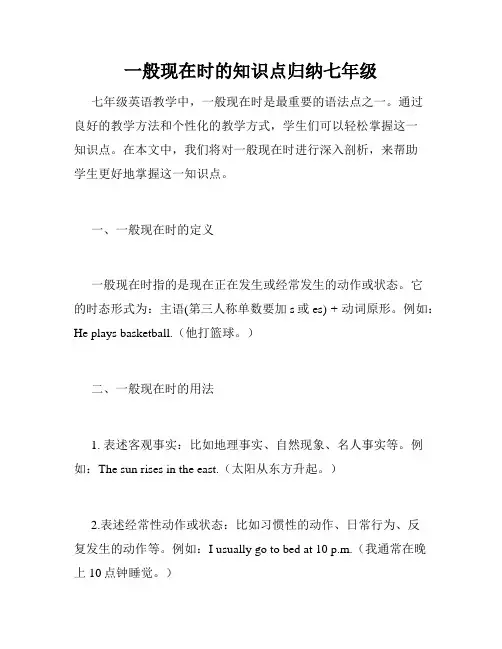
一般现在时的知识点归纳七年级七年级英语教学中,一般现在时是最重要的语法点之一。
通过良好的教学方法和个性化的教学方式,学生们可以轻松掌握这一知识点。
在本文中,我们将对一般现在时进行深入剖析,来帮助学生更好地掌握这一知识点。
一、一般现在时的定义一般现在时指的是现在正在发生或经常发生的动作或状态。
它的时态形式为:主语(第三人称单数要加s或es) + 动词原形。
例如:He plays basketball.(他打篮球。
)二、一般现在时的用法1. 表述客观事实:比如地理事实、自然现象、名人事实等。
例如:The sun rises in the east.(太阳从东方升起。
)2.表述经常性动作或状态:比如习惯性的动作、日常行为、反复发生的动作等。
例如:I usually go to bed at 10 p.m.(我通常在晚上10点钟睡觉。
)3.表述真理或普遍事实:比如科学定理、社会现象、人定律等。
例如:Water freezes at 0 degrees Celsius.(水在零度时结冰。
)4. 表示主语所具备的特征等性质。
例如:She is kind and friendly.(她友善又和蔼。
)三、一般现在时的标志词一般现在时没有专门的标志词,但在使用中,我们通常可以根据上下文来判断。
四、一般现在时的否定句和疑问句1.否定句:在be动词后加not,其他动词在前面加助动词do/does,其后紧随not。
例如:He does not run fast.(他跑得不快。
)2. 疑问句:将助动词do/does提前到主语前,其他句子成分不变。
例如: Do you like playing basketball?(你喜欢打篮球吗?)五、常见的时间状语时间状语指的是句子中表示时间的词或短语。
以下是常见的时间状语:1. every day (每天)2. every week (每周)3. every month (每月)4. every year (每年)5. on Monday (在星期一)6. in the morning (在早晨)7. at night (在晚上)8. at the weekend (在周末)六、一般现在时常见错误1. 第三人称单数动词形式错误:在第三人称单数主语后要加s/es。
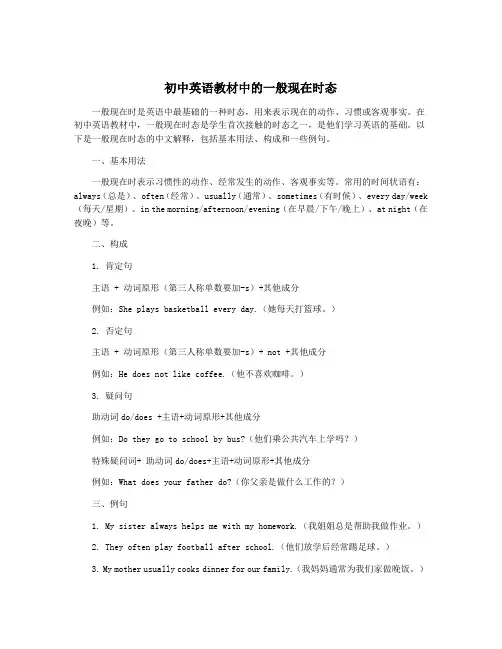
初中英语教材中的一般现在时态一般现在时是英语中最基础的一种时态,用来表示现在的动作、习惯或客观事实。
在初中英语教材中,一般现在时态是学生首次接触的时态之一,是他们学习英语的基础。
以下是一般现在时态的中文解释,包括基本用法、构成和一些例句。
一、基本用法一般现在时表示习惯性的动作、经常发生的动作、客观事实等。
常用的时间状语有:always(总是)、often(经常)、usually(通常)、sometimes(有时候)、every day/week (每天/星期)、in the morning/afternoon/evening(在早晨/下午/晚上)、at night(在夜晚)等。
二、构成1. 肯定句主语 + 动词原形(第三人称单数要加-s)+其他成分例如:She plays basketball every day.(她每天打篮球。
)2. 否定句主语 + 动词原形(第三人称单数要加-s)+ not +其他成分例如:He does not like coffee.(他不喜欢咖啡。
)3. 疑问句助动词do/does +主语+动词原形+其他成分例如:Do they go to school by bus?(他们乘公共汽车上学吗?)特殊疑问词+ 助动词do/does+主语+动词原形+其他成分例如:What does your father do?(你父亲是做什么工作的?)三、例句1. My sister always helps me with my homework.(我姐姐总是帮助我做作业。
)2. They often play football after school.(他们放学后经常踢足球。
)3. My mother usually cooks dinner for our family.(我妈妈通常为我们家做晚饭。
)4. Tom sometimes visits his grandparents on weekends.(汤姆有时候在周末去看望他的祖父母。
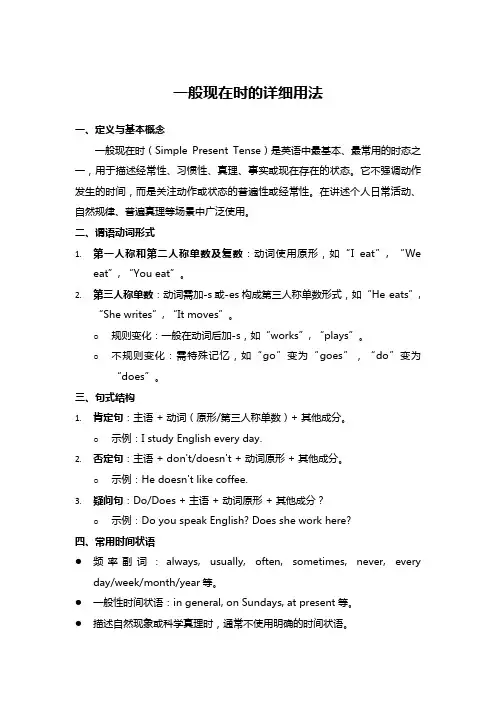
一般现在时的详细用法一、定义与基本概念一般现在时(Simple Present Tense)是英语中最基本、最常用的时态之一,用于描述经常性、习惯性、真理、事实或现在存在的状态。
它不强调动作发生的时间,而是关注动作或状态的普遍性或经常性。
在讲述个人日常活动、自然规律、普遍真理等场景中广泛使用。
二、谓语动词形式1.第一人称和第二人称单数及复数:动词使用原形,如“I eat”, “Weeat”, “You eat”。
2.第三人称单数:动词需加-s或-es构成第三人称单数形式,如“He eats”,“She writes”, “It moves”。
o规则变化:一般在动词后加-s,如“works”, “plays”。
o不规则变化:需特殊记忆,如“go”变为“goes”,“do”变为“does”。
三、句式结构1.肯定句:主语 + 动词(原形/第三人称单数)+ 其他成分。
o示例:I study English every day.2.否定句:主语 + don't/doesn't + 动词原形 + 其他成分。
o示例:He doesn't like coffee.3.疑问句:Do/Does + 主语 + 动词原形 + 其他成分?o示例:Do you speak English? Does she work here?四、常用时间状语●频率副词:always, usually, often, sometimes, never, everyday/week/month/year等。
●一般性时间状语:in general, on Sundays, at present等。
●描述自然现象或科学真理时,通常不使用明确的时间状语。
五、特殊用法1.表示将来确定会发生的事情:在时间状语从句或条件状语从句中,主句使用一般将来时,从句则用一般现在时代替一般将来时。
o示例:If it rains tomorrow, we won't go to the park.2.描述心理感觉或状态:如“I see”, “I feel”等,表示当前的心理感受或状态。
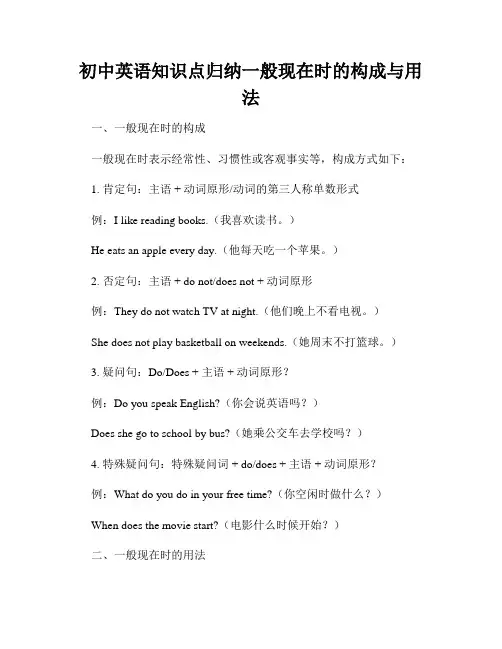
初中英语知识点归纳一般现在时的构成与用法一、一般现在时的构成一般现在时表示经常性、习惯性或客观事实等,构成方式如下:1. 肯定句:主语 + 动词原形/动词的第三人称单数形式例:I like reading books.(我喜欢读书。
)He eats an apple every day.(他每天吃一个苹果。
)2. 否定句:主语 + do not/does not + 动词原形例:They do not watch TV at night.(他们晚上不看电视。
)She does not play basketball on weekends.(她周末不打篮球。
)3. 疑问句:Do/Does + 主语 + 动词原形?例:Do you speak English?(你会说英语吗?)Does she go to school by bus?(她乘公交车去学校吗?)4. 特殊疑问句:特殊疑问词 + do/does + 主语 + 动词原形?例:What do you do in your free time?(你空闲时做什么?)When does the movie start?(电影什么时候开始?)二、一般现在时的用法一般现在时用于以下几种情况:1. 表示经常性或习惯性的动作或状态。
例:My mother often cooks dinner for us.(我妈妈经常给我们做晚饭。
)We usually go to the park on weekends.(我们通常在周末去公园。
)2. 表示客观事实、自然规律或科学真理。
例:The sun rises in the east.(太阳从东方升起。
)Water boils at 100 degrees Celsius.(水在100摄氏度沸腾。
)3. 表示现有状况或个人特征。
例:I have two cats.(我有两只猫。
)She lives in London.(她住在伦敦。
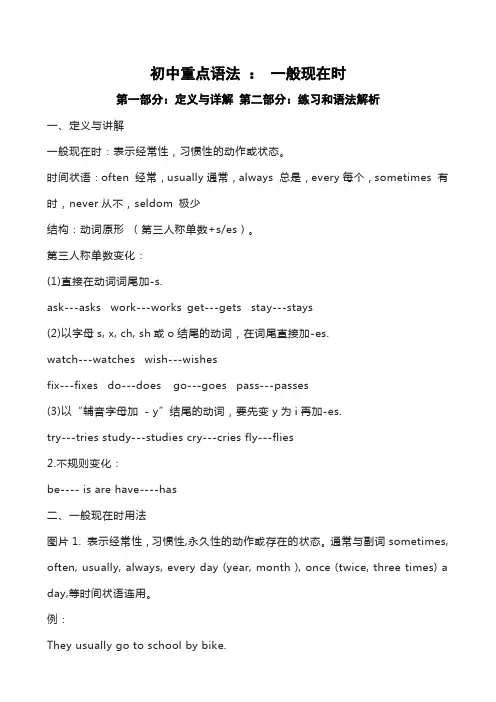
初中重点语法:一般现在时第一部分:定义与详解第二部分:练习和语法解析一、定义与讲解一般现在时:表示经常性,习惯性的动作或状态。
时间状语:often 经常,usually通常,always 总是,every每个,sometimes 有时,never从不,seldom 极少结构:动词原形(第三人称单数+s/es)。
第三人称单数变化:(1)直接在动词词尾加-s.ask---asks work---works get---gets stay---stays(2)以字母s, x, ch, sh或o结尾的动词,在词尾直接加-es.watch---watches wish---wishesfix---fixes do---does go---goes pass---passes(3)以“辅音字母加- y”结尾的动词,要先变y为i再加-es.try---tries study---studies cry---cries fly---flies2.不规则变化:be---- is are have----has二、一般现在时用法图片1. 表示经常性,习惯性,永久性的动作或存在的状态。
通常与副词sometimes, often, usually, always, every day (year, month ), once (twice, three times) a day,等时间状语连用。
例:They usually go to school by bike.I take the medicine three times a day.She helps her mother once a week.Mary’s father is a policeman.There are 50 students in my class.2. 表示客观真理,科学原理,自然现象,等客观事实或格言,谚语等。
例:The sun rises in the east and sets in the west every day.Tomorrow is Tuesday.三、一般现在时的句型转换(1)当句子中有be动词或情态动词时,则把be动词或情态动词(can,could等等)提到主语的前面变成疑问句;在be动词或情态动词后面加not变成否定句.例:①陈述句:She is a student.疑问句→Is she a student?否定句→She is not a student.②陈述句:I can swim.疑问句→Can you swim?否定句→I can not swim.(2) 当句子中即没有be动词,也没有情态动词时,则在主语前加助动词do (you,以及复数), does(单数she,he,it)变成问句;在主语后谓语动词前加助动词don’t(I,you,以及复数), doesn’t(单数she,he,it)变成否定句,助动词后的动词要变成动词原形。
初中英语语法知识之一般现在时一、一般现在时的定义一般现在时是英语中最基本的时态之一,用于描述经常发生的事情、普遍的真理、长期存在的状态等。
二、一般现在时的构成一般现在时的肯定句结构为:主语 + 动词原形(第三人称单数需加-s/-es)+ 其他。
例如:•He plays basketball every day.(他每天打篮球。
)•I like watching movies.(我喜欢看电影。
)一般现在时的否定句结构为:主语 + do/does not + 动词原形 + 其他。
例如:•He does not play basketball every day.(他不是每天打篮球。
)•I do not like watching movies.(我不喜欢看电影。
)一般现在时的疑问句结构为:Do/Does + 主语 + 动词原形 + 其他?例如:•Does he play basketball every day?(他每天打篮球吗?)•Do you like watching movies?(你喜欢看电影吗?)三、一般现在时的用法1. 描述日常习惯一般现在时经常用来描述日常习惯或经常发生的动作。
表示频率的副词有:always(总是)、often(经常)、usually(通常)、sometimes(有时候)、rarely(很少)、never(从不)等。
例如:•She always eats breakfast before going to school.(她上学前总是吃早餐。
)•They often go shopping on weekends.(他们经常在周末去购物。
)2. 表达客观事实或普遍真理一般现在时也被用来表达客观事实或普遍真理。
例如:•The Earth revolves around the sun.(地球绕太阳运行。
)•Water boils at 100 degrees Celsius.(水在100摄氏度沸腾。
一般现在时含义和用法定义:一般现在时表示现在经常反复发生的动作、存在的状态或习惯性的动作的时态。
构成:一般现在时用行为动词的原形,但第三人称单数作主语时,动词的词尾要加-S.(一般的动词词尾+S.以sh/ch/s/x结尾的词+es.以辅音字母Y结尾的把Y变成i,+es.辅音字母+o结尾的+es.)用法:1.表示经常的或习惯性的动作,常与表示频度的时间状语连用。
一般现在时的用法:1) 经常性或习惯性的动作,常与表示频度的时间状语连用。
时间状语:always,usually,regularly,everymorning/night/evening/day/week,often,sometimes,occasionally,from time to time,twice a week,rarely,seldom,once a month hardly ever,never.I leave home for school at 7 every morning.2) 客观真理,客观存在,科学事实。
The earth moves around the sun.Shanghai lies in the east of China.3) 表示格言或警句中。
Pride goes before a fall.骄者必败。
2.表示主语具备的性格、能力和特征。
3.表示现在的状态。
4.表示客观事实和普遍真理。
5.在时间状语从句和条件状语从句中,常用一般现在时代替将来时。
6.表示预先计划或安排好的行为。
7.小说故事用一般现在时代替一般过去时。
8.有些表示状态和感觉的动词表示现在发生的具体行为时,只用一般现在时,而不用进行时态。
9.表示现在发生的具体动作或存在的状态。
一般现在时的定义和结构一、一般现在时的定义一般现在时是英语中最基本的时态之一,用来描述现在经常发生的动作、事实或状态。
它表示的是客观事实、普遍真理或经常性的动作或状态。
二、一般现在时的结构一般现在时的结构主要由主语+谓语动词构成。
谓语动词可以是原形动词,也可以加上第三人称单数的-s或-es。
1. 肯定句结构:主语+谓语动词(原形/第三人称单数形式)例如:- I play basketball every weekend.(我每个周末打篮球。
)- He loves to read books.(他喜欢读书。
)2. 否定句结构:主语+do/does not+谓语动词(原形)例如:- She does not eat meat.(她不吃肉。
)- We do not watch TV in the morning.(我们早上不看电视。
)3. 疑问句结构:Do/Does+主语+谓语动词(原形)+其他?例如:- Do you like swimming?(你喜欢游泳吗?)- Does she go to school by bus?(她坐公交车去学校吗?)4. 特殊疑问句结构:疑问词+do/does+主语+谓语动词(原形)+其他?例如:- What do you do in your free time?(你在空闲时间做什么?)- Where does he live?(他住在哪里?)三、一般现在时的用法1. 表示经常性的动作或习惯:- I usually have breakfast at 7 o'clock.(我通常在7点吃早饭。
)- They always go to the gym after work.(他们下班后总是去健身房。
)2. 表示客观事实或普遍真理:- The sun rises in the east.(太阳从东方升起。
)- Water boils at 100 degrees Celsius.(水在100摄氏度沸腾。
一、一般现在时(一)定义表示经常性或习惯性的动作,或存在的状态,还表示主语具备的性格和能力及客观真理。
例:I get up at6:30in the morning.She is at home.(二)构成主要用动词原形表示,当主语是第三人称单数时,在动词词尾加s/es。
(三)句型1、肯定句:主语+谓语+其他。
She reads English everyday.2、否定句:主语+don’t/doesn’t+谓语+其他。
He doesn’t get up at6:30in the morning.3、一般疑问句:Do/Does+主语+V原+其他?Do you like English?Yes,I do./No,I don’t.4、特殊疑问句:特殊疑问词+do/does+主语+V原+其他?What time do you get up every morning?(四)用法1、表示经常性或习惯性的动作,或存在的状态,带与表示频率的时间状语如:often,sometimes, usually, always, everyday year, month...),once/twice a week(month, year, etc.), seldom, on Sunday等连用。
I leave home for school at seven every morning.2、表示客观真理,科学事实、格言警句。
The earth goes around the sun.地球绕着太阳转。
Ten minus two is eight.十减二等于八。
3、根据英文语法规定,当主句的谓语动词是一般将来时,那么时间或条件状语从句的谓语动词只能用一般现在时来表示将来要发生的动作。
I'll tell him the news when he comes back.他回来时,我将告诉他这个消息。
If you come this afternoon,we’ll have a meeting.如果你今天下午回来,我们将开会。
初中英语8大时态结构及用法,赶快收藏!时态无疑是初中英语最重要的语法内容,学好时态基本就拿下了语法的半壁江山。
今天总结的八种时态是大家在初中阶段必学必考的,复习时一定要加倍重视哦!一、一般现在时1、概念:表示经常发生的情况;有规律出现的情况;总是发生的;和事实真理。
2.时间状语: Always, usually, often, sometimes, every week (day, year, month…), once a week (day, year, month…), on Sundays (on Mondays…)3.基本结构:动词原形(如主语为第三人称单数,动词上要改为第三人称单数形式)4.否定形式:主语+am / is / are+not+其他;此时态的谓语动词若为行为动词,则在其前加don't,如主语为第三人称单数,则用doesn't,同时还原行为动词。
5.一般疑问句:把be动词放于句首;用助动词do提问,如主语为第三人称单数,则用does,同时,还原行为动词。
eg:①It seldom snows here.这里很少下雪。
②He is always ready to help others.他总是乐于帮助别人。
③Action speaks louder than words.事实胜雄辩。
二、一般过去时1.概念:过去某个时间里发生的动作或状态;过去习惯性、经常性的动作、行为。
2.时间状语:ago, yesterday, the day before yesterday, last week, last (year,ni ght,month…), in 1989, just now, at the age of 5, one day, long long ago, once upon a time,etc.3.基本结构:主语+动词的过去式或 be 的过去式+名词4.否定形式:主语+was / were+not+其他;在行为动词前加didn't,同时还原行为动词。
1. 一般现在时的概念
一般现在时表示经常的、习惯性的动作或存在的状态。
2. 一般现在时的构成
一般现在时的构成主要有两种形式:
(1)be型:句子的谓语动词只有be(am,is或are):
a.肯定句中,只出现be,如:I am a student.我是一名学生。
b.否定句中,要在be后面加not,如:She isn't a teacher.她不是教师。
c.一般疑问句,要将be放在句子开头(注意句首字母大写),句尾用问号,答语用Yes,主语+be.或No,主语+be+not.如:
—Are you ready?—你准备好了吗? —Yes,I am.—是的,我准备好了。
(—No,I'm not.—不,我没准备好。
)
(2)实义动词型:句中的谓语动词为实义动词(也叫行为动词):
a.肯定句中,只出现实义动词,如:
I get up in the morning.我早晨起床。
b.否定句中,要在实义动词前面加do(does)+not,do(does)作助动词,本身无意义,常与not缩写成don't(doesn't),如:
I don't like vegetables.我不喜欢蔬菜。
c.一般疑问句,要在句子开头加助动词Do(does),句尾用问号,简略答语用Yes,主语+do(does).或No,主语+do(does)+not.如:
—Do you like oranges?—你喜欢桔子吗?
—Yes,I do.—是的,我喜欢。
(—No,I don't.—不,我不喜欢。
)
重点:动词原形和动词第三人称单数形式
(1)当主语是第三人称单数形式(he、she、it;单一的人;单一的名字;单一的事物),动词要用单三形式。
实义动词变第三人称单数的规则:
①一般情况直接加“s”,如:come---comes,meet---meets
②动词以o,s,sh,ch, x结尾,加“es”,如:do--does; go--goes; teach--teaches
③以辅音字母+y结尾,变y为i,再加es, 如:study--studies, fly--flies, try--tries
④特殊情况:have--has
(2)句型转换
①当主语为第三人称单数:变否定句时,在动词前加doesn’t, 动词现原形;变一般疑问句
时,在句首加does,动词现原形。
一般疑问句的肯定回答:Yes, 人称代词+does;否定回答:No, 人称代词+doesn’t.
如:She has small eyes.
---She doesn’t have small eyes.
---Does she have small eyes?
---Yes, she does. /No, she doesn’t.
②当主语为第一、第二人称变否定句,在动词前加don’t,变一般疑问句,在句首加do,肯定回答:Yes, 人称代词+do;否定回答:No,人称代词+don’t.
They have small eyes.
---They don’t have small eyes.
--- Do they have small eyes?
---Yes, they do. / No, they don’t.
3.一般现在时的用法
1) 经常性或习惯性的动作,常与表示频度的时间状语连用,如:every…, sometimes, at…, on Sunday等。
I leave home for school at 7 every morning. 我每天早上7点去上学。
2) 客观真理,客观存在,科学事实。
The earth moves around the sun. 地球绕着太阳。
Shanghai lies in the east of China. 上海位于中国的东部。
3) 表示格言或警句中。
Pride goes before a fall. 骄者必败。
注意:此用法如果出现在宾语从句中,即使主句是过去时,从句谓语也要用一般现在时。
例:Columbus proved that the earth is round.
4) 现在时刻的状态、能力、性格、个性。
Xiao Wang writes good English but does not speak well.
小王的英语书面表达能力比口语好。
比较:Now I put the sugar in the cup.
练习
1. We often______(play) in the playgound.
2. He _____(get) up at six o’clock.
3. _____you ______(brush) your teeth every morning.
4. What (do) ______he usually (do)______ after school?
5. Danny _____(study) English,Chinese,Maths,Science and Art an school.
6. Mike sometimes ________(go) to the park with his sister.
7. At eight at night, she __________(watch) TV with his parents.
8. ________ Mike________(read) English every day?
9. How many lessons_________your classmate________(have) on Monday?
10. What time_________his mother_________(do) the housework?
改句子
1. Do you often play football after school? (肯定回答)
2. I have many books. (改为否定句)
3. Gao Shan’s sister likes playing table tennis (改为否定句)
4. She lives in a small town near New York. (改为一般疑问句)
5. I watch TV every day. (改为一般疑问句)
6. David has got a goal. (改为一般疑问句)
7. We have four lessons.(否定句)
8. Nancy doesn’t run fast (肯定句)
9. My dog runs fast.
否定句:
一般疑问句:
10. Mike has two letters for him.
一般疑问句:
否定句:
11. I usually play football on Friday afternoon.
否定句:
一般疑问句:
12. Su Yang usually washes some clothes on Saturday.
否定句:
一般疑问句:
13. Mingming usually waters the flowers every day
否定句:
般疑问句:
14. Tom does his homework at home.
否定句:
一般疑问句:。